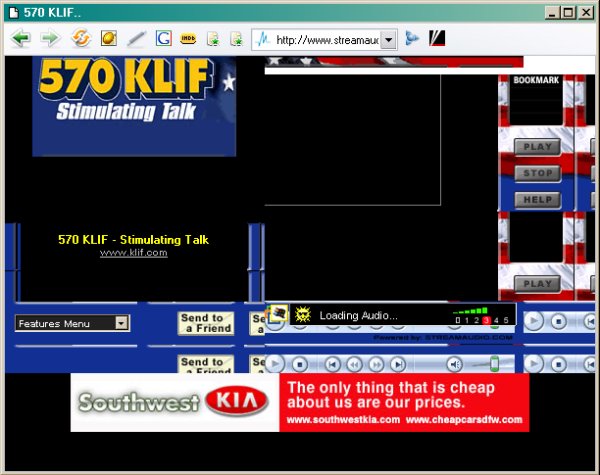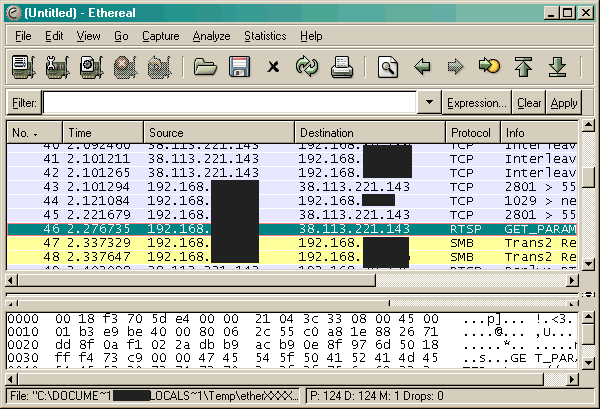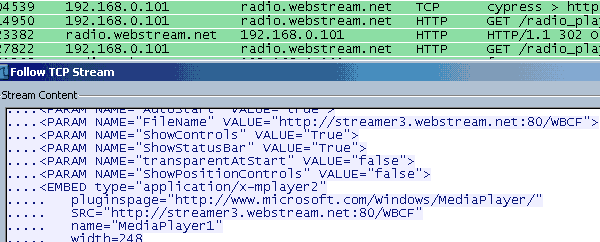Difference between revisions of "RTSP Streaming Radio Address Hacking"
m |
m |
||
| (27 intermediate revisions by one user not shown) | |||
| Line 1: | Line 1: | ||
| + | <big><big>Whats the REAL [[RTSP]] address of that radio station's stream?</big></big> | ||
| + | So you can listen directly from your audio player without having to goto the web site, open a popup with advertisments while listening. | ||
| − | == | + | == CASE EXAMPLE #1 == |
| − | + | See our [[Internet Radio Guide]] or surf to the [http://streamingradioguide.com/ Streaming Radio Guide] web site and find a live program [http://streamingradioguide.com/radio-show.php?showid=564 such as The Radio Factor] you wish to listen to. | |
You select a station, such as [http://www.klif.com/ KLIF AMHD] in Dallas, TX that has the program you want to hear as streaming Internet audio. | You select a station, such as [http://www.klif.com/ KLIF AMHD] in Dallas, TX that has the program you want to hear as streaming Internet audio. | ||
| Line 11: | Line 13: | ||
[[Image:Streaming Radio Hacking 01.png]] | [[Image:Streaming Radio Hacking 01.png]] | ||
| | | | ||
| − | If you have never noticed, radio station Internet web sites tend to be among the most annoying and | + | If you have never noticed, radio station Internet web sites tend to be among the most annoying and amateur web sites. After wading though popup advertisements and pictures of obnoxious morons, you find the link to the "LIVE Stream". With this site the link is fortunately on the home page. |
|} | |} | ||
| + | |||
| + | Clicking on the link doesn't directly open the windows media player or audio player of your choice as you might expect. Instead, it opens an OBNOXIOUS TO THE EXTREME POPUP window full of nasty frames, a repeating background image of the audio player controls, banners, and advertisements. Right clicking on what appears to be the windows media player in mini mode yields no menu options. | ||
| + | |||
| + | [[Image:Streaming Radio Hacking 02.jpg]] | ||
| + | *Wow, what an ugly a$$ box of bad HTML, nasty flashing banners, broken stuff, and dopey repeating background images! | ||
| + | |||
| + | How do you find the stream to access direct? | ||
| + | |||
| + | * cannot right click and view properties | ||
| + | * view source does not reveal the true stream source | ||
| + | |||
| + | Easy, using a tool such as tcpdump or Ethereal* for Windows.<BR> | ||
| + | <nowiki>*</nowiki> The Ethereal project was forced to change names in May 2006 due to trademark issues. It is now called [http://sourceforge.net/project/showfiles.php?group_id=255 Wireshark]. | ||
| + | |||
| + | Lets do some sniffing and see what our computer is talking to while listening to the streaming audio from the obnoxious windows media player trapped in frames with advertisments browser window. Choose the correct interface, and capture a sample of about 30 seconds. It doesn't require you capture much to find what you are looking for. The less your computer is doing Internet connection wise while you do the capture the better. | ||
| + | |||
| + | [[Image:Streaming Radio Hacking 03.png]] | ||
| + | |||
| + | Found it. "[[RTSP]] Protocol" which stands for Real Time Streaming Protocol. | ||
| + | |||
| + | [[Image:Streaming Radio Hacking 04.png]] | ||
| + | |||
| + | The entire RTSP address does not show up on the screen. Now choose "Follow TCP Stream" - here you can actually capture and save the audio stream. A Filter is automatically created in the main window of Ethereal. | ||
| + | |||
| + | Right click, select PRINT. Choose Output To File. This will save the RTSP path along with the packet info into a text file. | ||
| + | |||
| + | Grab the RTSP path from the text file | ||
| + | |||
| + | rtsp://uni3.susq.streamaudio.com/KLIF_AM?SAT=92ac3c8c8afbb49956a3fc671cd59042&ts=1187368029332&s=920&y=2007&m=8&d=17&hh=9&mm=27&ss=8 RTSP/1.0 | ||
| + | |||
| + | Open Windows Media Player and enter the path... or use your alternative player such as VLAN player. Now you are listening to the audio stream directly in the native player without the obnoxious crap from the web site. | ||
| + | |||
| + | | ||
| + | |||
| + | == CASE EXAMPLE #2 == | ||
| + | |||
| + | In this example RTSP does not appear in the tcp stream. Using Wireshark (formerly Ethereal) we analyze the interface traffic. Be sure to start the capture prior to clicking the link on the radio station web site that starts the audio. | ||
| + | |||
| + | [[Image:caseexample20000001.png]] | ||
| + | |||
| + | It's just a matter of following the TCP Stream and looking for the URI of the media resource. In this case we are simply viewing the HTML within the packet and locating the URI. This is convenient when the "view source" option is disabled in the web browser by the site developer. They don't want you to know the direct URI, because they don't want you to bypass their advertisements. | ||
| + | |||
| + | In this example the direct URI is http://streamer3.webstream.net:80/WBCF which will cause the browser to launch Windows Media Player and go directly to the stream. | ||
| + | |||
| + | == updates to this article == | ||
| + | Many web sites are not longer using rtsp. Some updates should be added here addressing more modern streaming methods. | ||
| + | |||
| + | Although not necessary for linux users, wireshark can be installed on most modern distributions. There are native tools that can accomplish the same thing wireshark does, yet some people prefer wireshark due to their familiarity with it as a software application. To install wireshark on a Mint/Ununtu distribution simply use the apt tool: | ||
| + | sudo apt install wireshark | ||
| + | |||
| + | | ||
| + | |||
| + | | ||
| + | |||
| + | [[Category:Computer_Technology]] | ||
| + | [[Category:Internet]] | ||
| + | [[Category:Networking]] | ||
| + | [[Category:Hacking]] | ||
Latest revision as of 15:05, 8 November 2022
Whats the REAL RTSP address of that radio station's stream? So you can listen directly from your audio player without having to goto the web site, open a popup with advertisments while listening.
CASE EXAMPLE #1
See our Internet Radio Guide or surf to the Streaming Radio Guide web site and find a live program such as The Radio Factor you wish to listen to.
You select a station, such as KLIF AMHD in Dallas, TX that has the program you want to hear as streaming Internet audio.
|
If you have never noticed, radio station Internet web sites tend to be among the most annoying and amateur web sites. After wading though popup advertisements and pictures of obnoxious morons, you find the link to the "LIVE Stream". With this site the link is fortunately on the home page. |
Clicking on the link doesn't directly open the windows media player or audio player of your choice as you might expect. Instead, it opens an OBNOXIOUS TO THE EXTREME POPUP window full of nasty frames, a repeating background image of the audio player controls, banners, and advertisements. Right clicking on what appears to be the windows media player in mini mode yields no menu options.
- Wow, what an ugly a$$ box of bad HTML, nasty flashing banners, broken stuff, and dopey repeating background images!
How do you find the stream to access direct?
- cannot right click and view properties
- view source does not reveal the true stream source
Easy, using a tool such as tcpdump or Ethereal* for Windows.
* The Ethereal project was forced to change names in May 2006 due to trademark issues. It is now called Wireshark.
Lets do some sniffing and see what our computer is talking to while listening to the streaming audio from the obnoxious windows media player trapped in frames with advertisments browser window. Choose the correct interface, and capture a sample of about 30 seconds. It doesn't require you capture much to find what you are looking for. The less your computer is doing Internet connection wise while you do the capture the better.
Found it. "RTSP Protocol" which stands for Real Time Streaming Protocol.
The entire RTSP address does not show up on the screen. Now choose "Follow TCP Stream" - here you can actually capture and save the audio stream. A Filter is automatically created in the main window of Ethereal.
Right click, select PRINT. Choose Output To File. This will save the RTSP path along with the packet info into a text file.
Grab the RTSP path from the text file
rtsp://uni3.susq.streamaudio.com/KLIF_AM?SAT=92ac3c8c8afbb49956a3fc671cd59042&ts=1187368029332&s=920&y=2007&m=8&d=17&hh=9&mm=27&ss=8 RTSP/1.0
Open Windows Media Player and enter the path... or use your alternative player such as VLAN player. Now you are listening to the audio stream directly in the native player without the obnoxious crap from the web site.
CASE EXAMPLE #2
In this example RTSP does not appear in the tcp stream. Using Wireshark (formerly Ethereal) we analyze the interface traffic. Be sure to start the capture prior to clicking the link on the radio station web site that starts the audio.
It's just a matter of following the TCP Stream and looking for the URI of the media resource. In this case we are simply viewing the HTML within the packet and locating the URI. This is convenient when the "view source" option is disabled in the web browser by the site developer. They don't want you to know the direct URI, because they don't want you to bypass their advertisements.
In this example the direct URI is http://streamer3.webstream.net:80/WBCF which will cause the browser to launch Windows Media Player and go directly to the stream.
updates to this article
Many web sites are not longer using rtsp. Some updates should be added here addressing more modern streaming methods.
Although not necessary for linux users, wireshark can be installed on most modern distributions. There are native tools that can accomplish the same thing wireshark does, yet some people prefer wireshark due to their familiarity with it as a software application. To install wireshark on a Mint/Ununtu distribution simply use the apt tool:
sudo apt install wireshark



